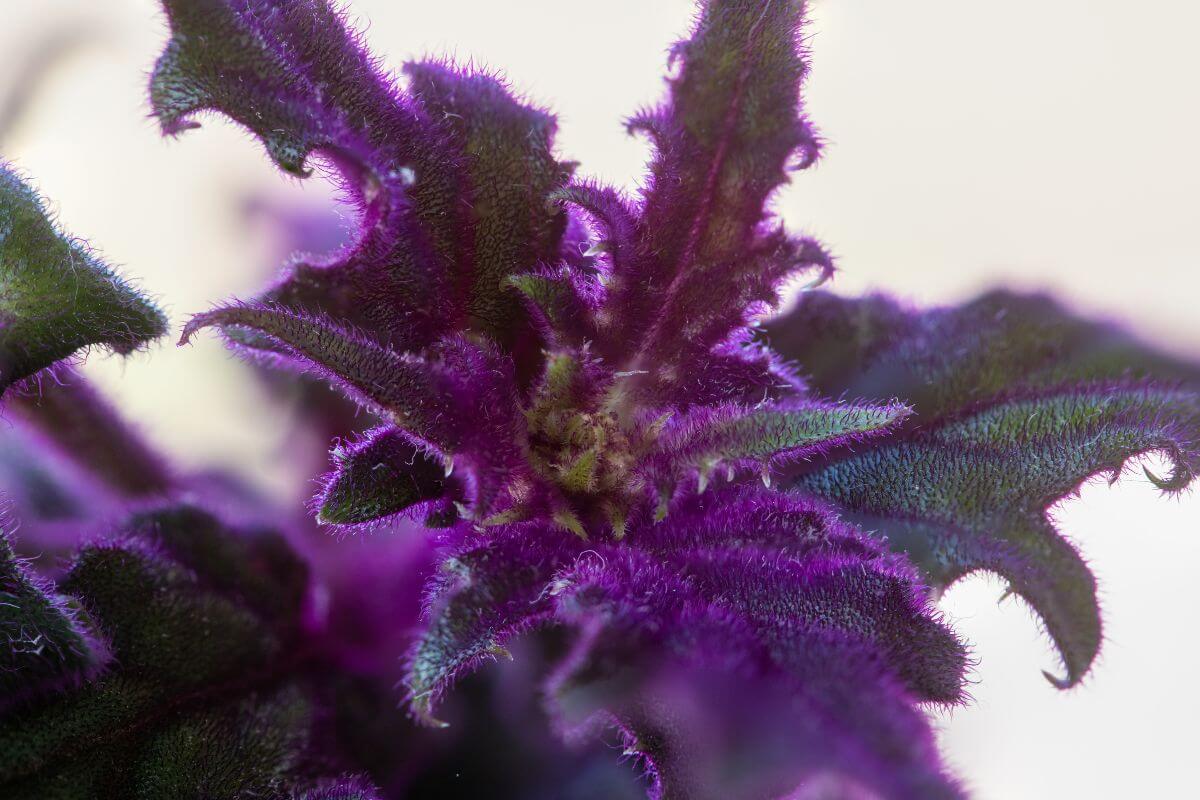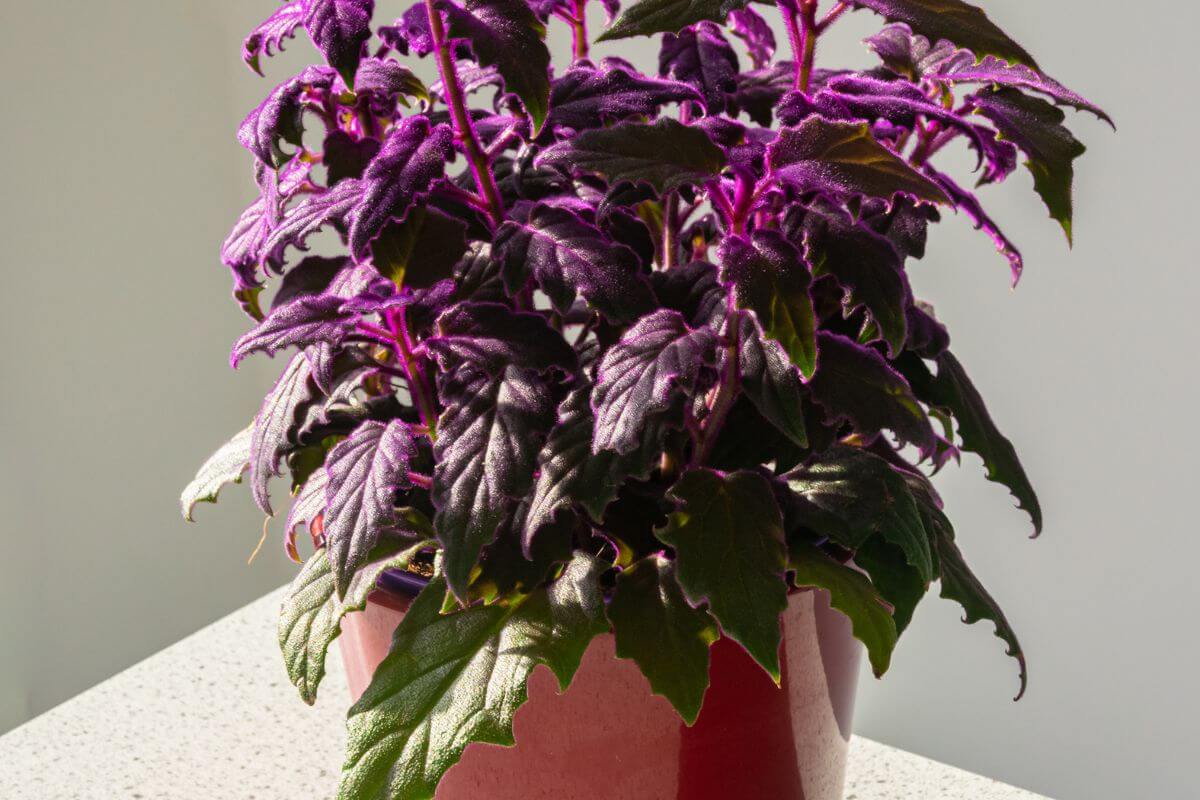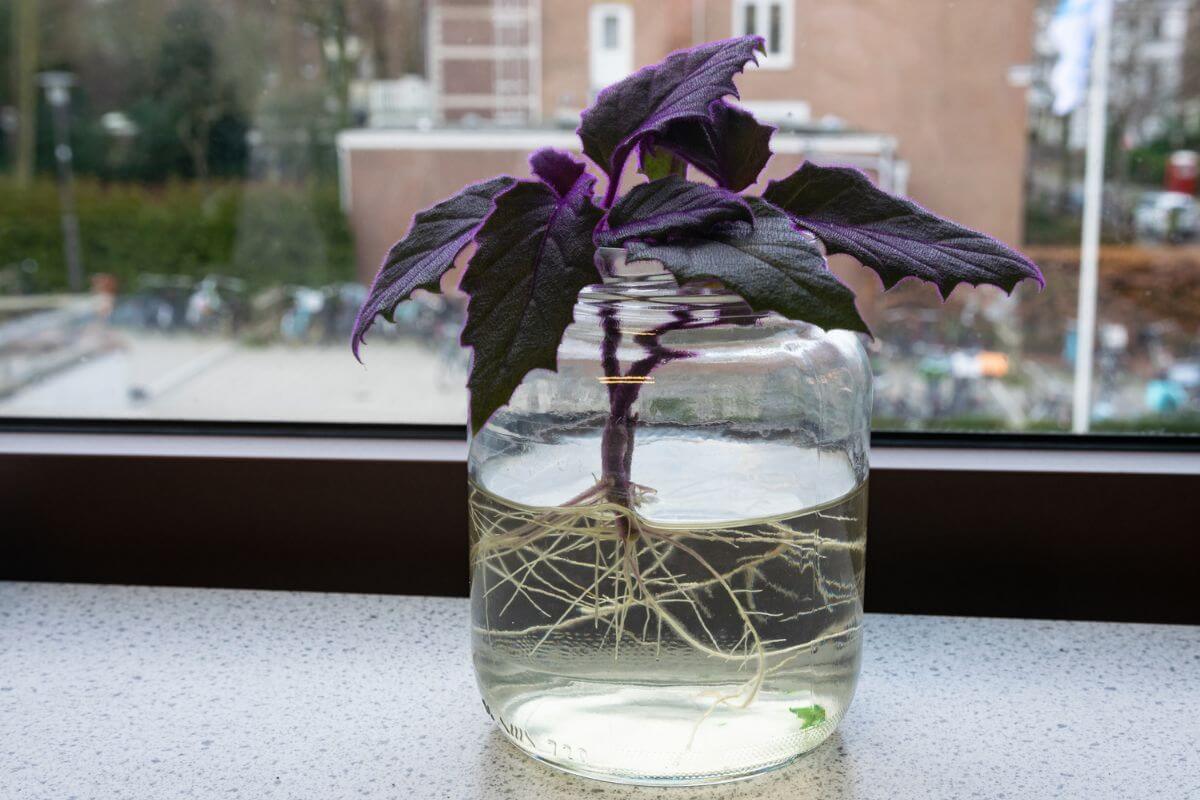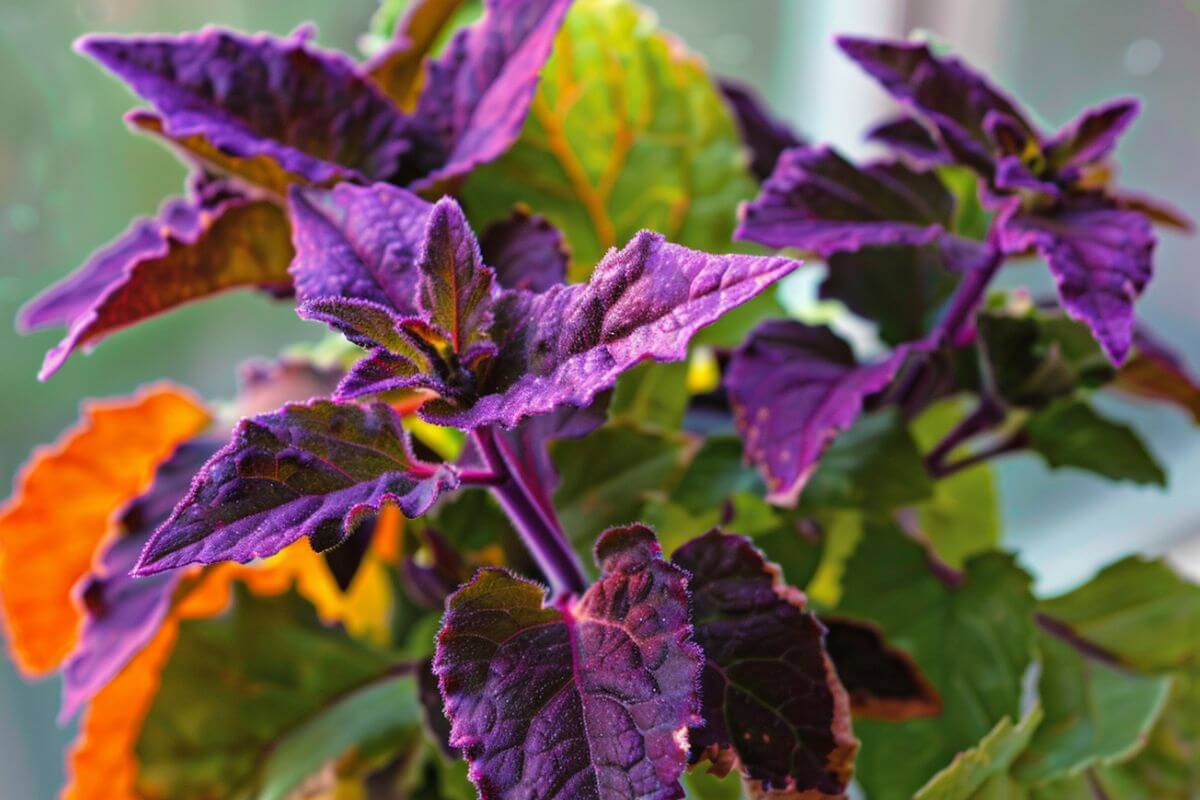Do you love the color purple?
If you do love purple and you love velvet, you won’t find a better houseplant to cultivate than the Purple Passion Plant.
This plant asks very little of its owners, yet rewards them with shades of purple wherever you put it. It’s easy care, low maintenance, and will grow in any climate. This is one of those plants that can be grown indoors or out!
This guide will help you learn about the purple passion plant and how to care for it.
Purple Passion Plant Overview

The Gynura aurantiaca, commonly known as the Purple Passion Plant, is a popular houseplant thanks to its stunning foliage. Native to Java and Indonesia, it is a member of the Asteraceae family and a perennial evergreen.
You may find it in garden centers or nurseries under the names of the Royal Velvet Plant or the Purple Velvet Plant. Cultivars also have names such as the Purple Passion Plant or the Purple Passion Vine.
As a tropical plant it can only be cultivated outdoors in USDA hardiness zones 10, 11, and 12. Therefore, it is more often found indoors as a houseplant.
The much-admired leaves of this plant are dark green yet covered with purple hair that is velvety in texture. Its purple leaves and velvety leaves combine to give it the popular name of purple passion plant.
These leaves are oval or elliptical, and can grow to be 8-inches in length, making it an impressive decoration wherever they are located. Leaf edges are jagged, adding to its somewhat exotic appearance.
The purple passion plant produces bright yellow blooms that resemble a common dandelion. Oddly enough, these flowers do not have a pleasant odor and removing them will help to reduce that smell.
This is a quick growing plant that will point upward as a young plant. As the plant reaches maturity, it will tend to sprawl, growing up to two feet long and up to three feet tall. Thus, younger plants are great for table or window decoration, while mature plants look very nice in hanging baskets.
Purple Passion Plant Care Guide
When cultivated indoors, the purple passion plant really requires very little care. This makes it an ideal houseplant for both beginners and those with limited time for home gardening.
Soil for the Purple Passion Plant
Purple passion plants will easily thrive in normal potting soil, as long as it’s well-draining. Make sure that the pot container it’s planted in also has good drainage.
Light for the Purple Passion Plant

The purple passion plant needs medium to bright light that is filtered and not direct. A north-facing window that is sunny is ideal when indoors for there indirect light.
In locations that provide strong, direct sunlight, take care because that beautiful foliage can scorch. Be sure to give them at least partial shade.
If you place your plant in a window that has stronger light, a sheer curtain will protect it from leaf scorching.
On the flip side, too little light will leave your plant reaching for the sun, leading it to become leggy and weaken.
Water for the Purple Passion Plant
While the purple passion likes a soil bed with even moisture, it does not like soggy soil. It is one of a number of plants at risk for root rot so avoid overwatering. When the soil bed feels dry to about an inch deep, it’s time to water.
Humidity and Temperature for the Purple Passion Plant
While the purple passion plant likes humidity as all tropical plants do, water on foliage should be avoided. For this reason, it may be better not to mist.
To increase humidity, use a humidifier or a pebble tray underneath your plant. Fill a tray with pretty stones and fill it about two-thirds with water.
Place the plant on the tray being careful that the tray water does not come into contact with the bottom of the plant’s container. Also, grouping plants together can increase humidity among them.
Purple passion plants are not a good choice for closed terrariums as the humidity will be too high and foliage will suffer. An open terrarium is a possibility for a smaller-sized plant.
It will do best if the room temperature measures between 60° and 70° Fahrenheit.
Fertilizer for the Purple Passion Plant
An all-purpose liquid fertilizer for feeding will be fine when given bi-weekly during the growing season. During the winter months in dormancy, this should be reduced to bi-monthly.
Propagating the Purple Passion Plant

The purple passion plant will develop roots easily with stem cuttings. To propagate with stem cuttings:
- Cut a piece of the mother plant from two to four inches in length
- Remove any leaves at the bottom of the cutting.
- You can place your stem cutting in water or in a starting mix or vermiculite.
- If you use a growing mix, dip the end in rooting hormone before inserting it in the growing medium.
Once roots have developed it can be transplanted into regular potting soil.
Pruning and Repotting the Purple Passion Plant
If you prefer a bushier purple passion plant, prune your purple passion plant and use the trimmings for cuttings for propagation.
A smaller plant will thrive when it is slightly rootbound. This will also help control its size.
As the plant ages, it will lose some of its color as it spreads. If you trim leaf tips, this will encourage new growth and increased vibrant colors. If the plant loses all its purple color, you can propagate with a stem cutting.
More mature plants do well in hanging baskets or on climbing structures like trellises.
Repotting is unlikely needed because these plants generally only live a few years.
Purple Passion Plant Blooms and Foliage
Selected mostly for its stunning foliage, the purple passion plant leaves have a striking appearance. Their deep green leaves are covered in purple hairs with a sheen that resembles velvet. The leaf’s underside is also purple.
The hairs on the leaves help to protect the plant from very high amounts of direct light. Water should be kept off the leaves, because if they become soggy, they can rot.
Blooms are bright yellow and resemble a common lawn dandelion. They emit an unpleasant aroma though.
When your indoor plant produces blooms, you will know that the plant has reached maturity, and you may want to take stem cuttings for propagation.
Purple Passion Plant Problems, Disease and Pests

Like many houseplants, the purple passion plant is susceptible to common pests including aphids, spider mites, and scale insects.
Caught early, pest can be removed with a damp cloth, or an organic insecticide like neem oil can be administered.
Although resistant to disease, they are not totally immune. Botrytis and Fusarium will cause the foliage to turn brown and die.
The diseases are more common outdoors, but contamination from gardening tools or soil, or through simple handling can infect a houseplant.
Fungicides can help an infected plant. You can remove the plant from its container, then wash the container and plant roots. Dip the roots in fungicide and replant them in fresh uninfected potting soil.
Purple Passion Plant Toxicity and Pets
According to the ASPCA (American Society for the Prevention of Cruelty to Animals), the purple passion plant is non-toxic to dogs and cats.
Purple Passion Plant Care Final Thoughts
The purple passion plant makes a great addition to any home. It is easy to care for and attractive, bringing some great color to your home.
For other houseplant care guides on beautiful plants, check these out:
- Calathea Plant Care and Grow Guide
- Epiphytic Plants Overview and Care Guide
- Sundew Plant Care and Grow Guide
Purple Passion Plant Care FAQs
How do you take care of a purple passion plant?
Take care of a purple passion plant by keeping it watered regularly. Keep the water away from the leaves so that they don’t get wet. Remove dead flowers and stems before they dry up. This helps prevent mold formation.
What kind of light does a purple passion plant need?
A purple passion plant needs bright indirect sunlight. Direct sun causes scorching which damages the leaves. A good location would be near a window where there’s natural daylight coming into the room.
Are purple passion plants easy to care for?
Yes, purple passion plants are easy to care for and grow. Just keep them well hydrated and fed every few weeks. If you notice signs of pest infestation, use organic pesticides as needed. There are no special requirements for their growth.
Are purple passion plants indoor or outdoor?
Purple passion plants can be grown both indoors and outdoors, but it’s better as an indoor plant. Outdoor temperatures fluctuate too much for this type of plant. Purple passion plants prefer warm weather climates. The best temperature range is between 65°F and 75°F during the day and 50°F at night.
How big do purple passion plants get?
Purple passion plants can grow up to 3 feet tall and 2 feet wide in its native Indonesia. You can also grow it close to that size by providing it with the right conditions.
Is the purple passion plant toxic to dogs?
No, the purple passion plant is not toxic to dogs nor other pets like cats. Feel free to grow them at home with pets and small children.
How long does a purple passion plant live?
A purple passion plant can live anywhere from 5 years to 10 years, depending on how often you feed it and what types of pests attack it. To keep it living longer, make sure it gets plenty of bright indirect sunlight, keep its soil moist and it has enough space to spread out.
Why is my purple passion plant dying?
Your purple passion plant could be dying because it doesn’t have enough nutrients. Make sure it receives regular watering and feeding. Also, it could be a pest infestation and if you see insects around it, try spraying insecticidal soap on the leaves to control the pests.


